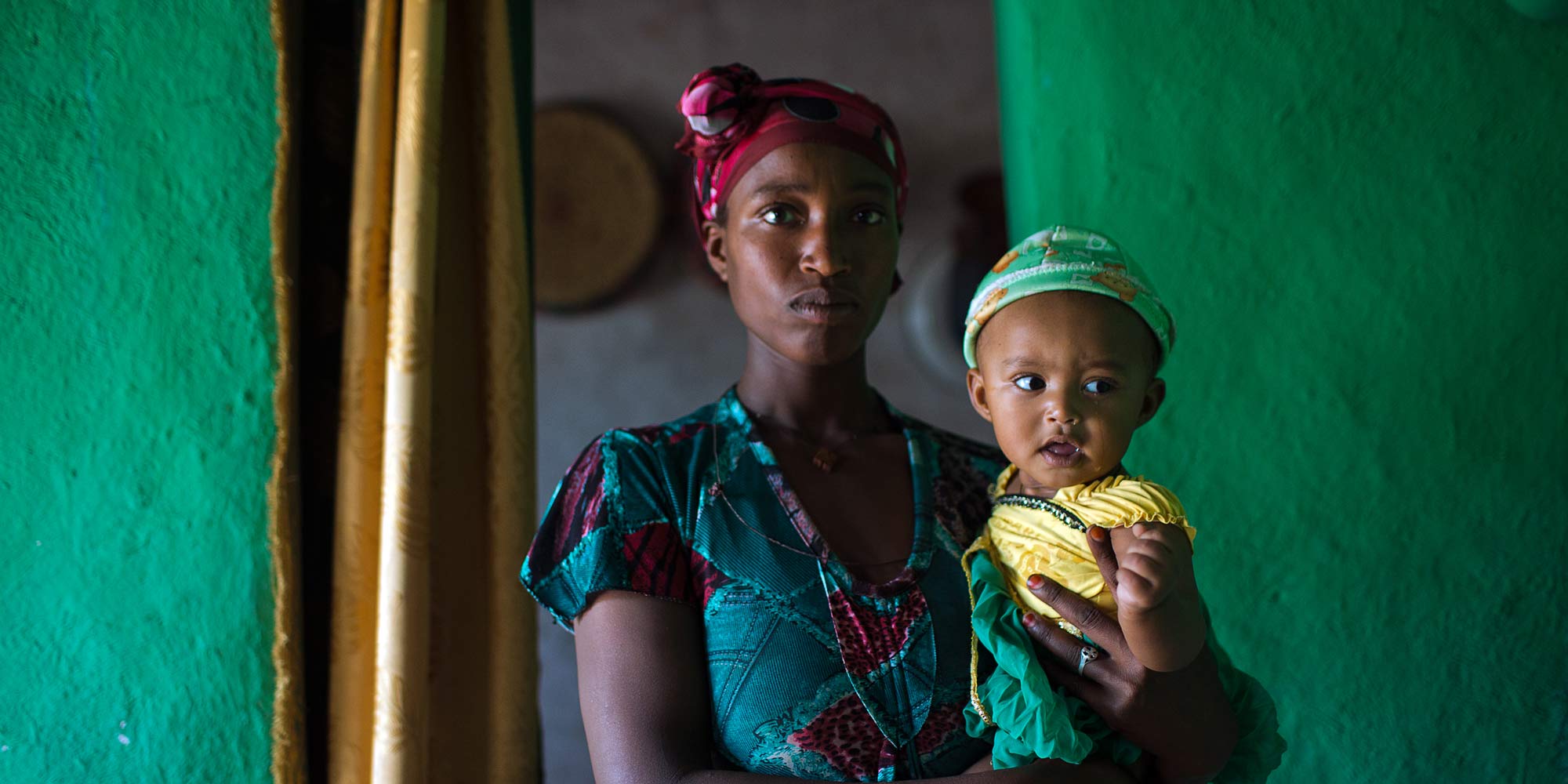Overview of DTP-containing vaccines
Vaccines against diphtheria, tetanus and pertussis (DTP) are a long-standing pillar of immunisation programmes worldwide, having played a key role in helping halve childhood mortality in Gavi-supported countries since 2000. According to a recent Lancet study, DTP-containing vaccines have saved over 40 million lives globally in the last 50 years by preventing diphtheria, tetanus and pertussis. Since 2000, Gavi implementing countries have ensured over 1.4 billion children have been protected with the vaccine.
The three antigens, diphtheria toxoid, tetanus toxoid and pertussis antigen, are commonly available: as combination vaccines, for example tetanus-diphtheria (Td), diphtheria-tetanus (DT) and diphtheria-tetanus-pertussis (DTP); with additional antigens, for example hepatitis B and Haemophilus influenzae type b (Hib); as pentavalent vaccines; and with inactivated polio vaccine (IPV) as hexavalent vaccines. As there are many different combination products available, these are generically referred to as DTP-containing vaccines (DTPcv). DTPcv boosters are necessary to sustain protection of infant vaccination for older children.[1]
DTP-containing vaccine boosters schedule
The World Health Organization (WHO) recommends three boosters against diphtheria and tetanus and at least one booster against pertussis, to be given at ages 12–23 months, 4–7 years and 9–15 years.
Table 1. WHO-recommended DTPcv boosters vaccination schedule [2],[3],[4]
| Primary series | First booster | Second booster | Third booster |
|---|---|---|---|---|
| Recommended age range | 3-dose series from 6 weeks of age, minimum interval 4 weeks between doses. The third dose should be scheduled by 6 months of age. | 12m–23m | 4yrs–7yrs | 9yrs–15yrs |
| Recommended vaccines | 3 doses of DTP-containing vaccine | One dose of DTP-containing vaccine | DT- or Td-containing vaccine (with or without pertussis) | Td-containing vaccine (with or without pertussis) |
| Vaccine options | DTP Quadrivalent Pentavalent | DTP Quadrivalent Pentavalent | Td (from >4yrs) or DT (if <7yrs) DTP | Td Tdap |
As combination vaccines, there are different products that countries can choose to use for boosters. Technical support is available from WHO to assist countries with these decisions. Gavi support is limited to combinations with whole-cell pertussis, as shown in table 2 below.
Table 2: Potential touchpoints for DTPcv boosters
Schedule | |
|---|---|
12m–23m Diphtheria, tetanus, whole-cell pertussis (DTwP) or pentavalent | Opportunity to leverage second year of life (2YL) contact and encourage co-administration with second dose of measles-containing vaccine (+malaria vaccine where applicable) |
4yrs–7yrs Td | No existing Essential Programme on Immunization (EPI) contact; will need enabling policies (e.g. vaccination requirements for school entry) |
9yrs–15yrs Td | Opportunity to leverage HPV vaccination contact (notably school-based delivery) and encourage co-administration of HPV vaccine and Td (where applicable) |
DTP boosters will reduce the number of antenatal clinic visits and Td vaccination injections received by pregnant women and other eligible people, as illustrated in Table 3 below.
Table 3: Tetanus toxoid-containing vaccines (TTCV) schedule for pregnant women and adults who were partially vaccinated during childhood and adolescence
| Age of last vaccination | Previous vaccinations (from vaccination record) | Recommended TTCV doses | |
|---|---|---|---|
| At present ANC contact/pregnancy | Later (with interval of at least one year) | ||
| Infancy | 3 TTCV primary doses | 2 doses of TTCV (minimum 4-week interval between doses) | 1 dose of TTCV |
| Early childhood/ school age | 3 TTCV primary doses + 2 boosters (total 5 TTCV doses) | 1 dose of TTCV | None (fully protected) |
| Adolescence | 3 TTCV primary doses + 3 boosters (total 6 TTCV doses) | None (fully protected) | None (fully protected) |
All doses should be properly recorded in the home-based record or ANC/maternal health card; and in the standard health facility register and tally sheet.
Accurate recording by dose number (i.e. TTCV2, TTCV3, etc.) is important so that unnecessary vaccinations can be avoided.
Benefits of DTPcv boosters programme
- Strengthen immunisation touchpoints beyond infancy: Providing boosters reinforces vaccination contacts during the second year of life (2YL) and in school health programmes, including integration with adolescent human papillomavirus (HPV) vaccination, where it has been introduced into the routine immunisation schedule. As a life-course vaccine, DTPcv boosters provide an opportunity for integrated services in primary health care.
- Addresses gender inequality of tetanus vaccination among boys/males: Currently, in many lower-income countries, females have greater protection against tetanus from Td vaccine offered to women of childbearing age, while boys are left unprotected. Recent tetanus cases due to male circumcision in Uganda[5] confirm the risk of tetanus disease in men.[6] As the DTPcv boosters vaccination schedule applies to all children, it will ensure equal opportunity for protection against tetanus into adulthood.
- Prevent vaccine-preventable diseases: There is evidence of waning immunity with recent diphtheria outbreaks, wherein most cases have been in older age groups. Three primary doses and three booster doses until adulthood confer high levels of sero-protection, at least up to age 39, and likely longer.
- Addresses global health inequities: DTPcv boosters protection will address the difference in immune protection between lower-income, Gavi-supported countries – which have a higher burden of tetanus and diphtheria – and a higher proportion of incomplete booster schedules than higher-income, non-Gavi supported countries.
- Opportunity for catch-up vaccination and reduction of immunity gap: The 12–23-month vaccination touchpoint provides opportunity for catch-up vaccination of missed primary series doses and helps to reduce diphtheria outbreaks.
- Supports maternal and neonatal tetanus elimination (MNTE) sustainability:The boosters also support sustaining the elimination of maternal and neonatal tetanus.
Gavi funding for DTP-containing vaccine boosters
In 2018, following the Vaccine Investment Strategy (VIS), the Gavi Board approved funding support for DTPcv boosters.[7] Gavi-eligible countries can apply for support to introduce any of the three WHO-recommended DTP-containing vaccine boosters into the national routine immunisation schedule. Countries can apply for support to introduce one, two or all three boosters. However, to ensure complete protection, three boosters are needed. Countries are eligible to apply for Vaccine Introduction Grants (VIGs) as shown in table 4 below. Provision of any booster is beneficial, and a country may choose to build their boosters programme prioritisation.
Starting 1 December 2023, countries eligible for Gavi support can apply[8] for DTPcv boosters, in line with WHO recommendations. For the second of life, first DTP booster touchpoint, Gavi support is available for vaccine doses and introduction grant. For the subsequent booster doses, Gavi support will be for grant support only and not vaccines (since the cost of Td is below the Gavi funding threshold).
Types of support
- Vaccine dose procurement and associated supplies support: For Gavi-eligible countries, this support will be aligned to the current co-financing principles, particularly for the 2YL booster dose (DTwP or pentavalent).
Note: Vaccine financing support will not be provided for tetanus-diphtheria (Td) – recommended for boosters at 4–7 years and 9–15 years – as long as the price remains equal to or below US$ 0.20 per dose, which is the minimum country co-financing based on the current Gavi policy.
- Vaccine Introduction Grant (VIG): For Gavi-eligible countries introducing DTP-containing vaccine boosters (DTwP, Td, or pentavalent), Gavi will provide a one-time VIG for each new booster contact at US$ 0.80/0.70/0.60 (as per country co-financing phase) per targeted child of the year of introduction, or a lump sum of US$ 100,000, whichever is higher (see table 4 below).
- Health system strengthening (HSS) support: Countries can decide to use their HSS grants (within the existing ceiling) to complement the funds provided under the VIG to support the sustained implementation of the DTP-containing vaccine boosters programme after accounting for other programmatic priorities. Allowable HSS support is detailed in the Gavi Programme Funding Guidelines. Countries are encouraged to explore other complementary funding, including domestic financing, to strengthen contacts beyond the first year of life.
- Targeted Country Assistance (TCA) support: TCA from in-country, regional and global partners to support the planning and implementation of the DTP-containing vaccine boosters programme may be available. Countries are encouraged to contact their Gavi Senior Country Manager for details.
Table 4: Financial support for DTPcv boosters introduction
| Transition phase | VIGs | Ops grants | Switch |
|---|---|---|---|
| Initial self-financing | US$ 0.80 per infant in the birth cohort (i.e. live births in the year of introduction) or a lump sum of US$ 100,000, whichever is higher | US$ 0.65 per targeted person | US$ 0.25 per infant in the birth cohort or a lump sum of US$ 30,000, whichever is higher |
| Preparatory transition | US$ 0.70 per infant in the birth cohort or a lump sum of US$ 100,000, whichever is higher | US$ 0.55 per targeted person | US$ 0.25 per infant in the birth cohort or a lump sum of US$ 30,000, whichever is higher |
| Accelerated transition | US$ 0.60 per infant in the birth cohort or a lump sum of US$ 100,000, whichever is higher | US$ 0.45 per targeted person | US$ 0.25 per infant in the birth cohort or a lump sum of US$ 30,000, whichever is higher |
Planning for Gavi support
Countries should allow for ample lead time from the application submission to the planned vaccine introduction. This lead time will provide sufficient time for the Independent Review Committee (IRC) review processes, confirmation of supply, distribution of the VIG, vaccine order and distribution, and adequate country-level planning for a successful introduction.
For each DTPcv booster, countries are required to identify a routine single cohort (within 12m–23m, 4yrs–7 yrs and 9yrs–15 yrs) to be immunised on an annual basis. Integration and alignment with other interventions and programmes, including co-administration with other vaccines given at the same age, is strongly encouraged – for example, second dose of measles-containing vaccine (MCV2), fourth dose of malaria vaccine (where applicable) or HPV vaccine.
To apply for any of the recommended DTP-containing vaccine boosters, the country is required to prepare a new vaccine introduction plan using the available WHO template. This plan should be completed as thoroughly as possible, covering all elements for a successful introduction and a sustainable programme.
Countries are strongly encouraged to reach out to neighbouring countries with existing DTPcv booster programmes and technical partners (in-country, regional and global) for guidance to learn about the successes and challenges of booster programmes. All countries planning to introduce a DTPcv booster are encouraged to notify Gavi of their intention, regardless of whether they are seeking a VIG for financial support.

